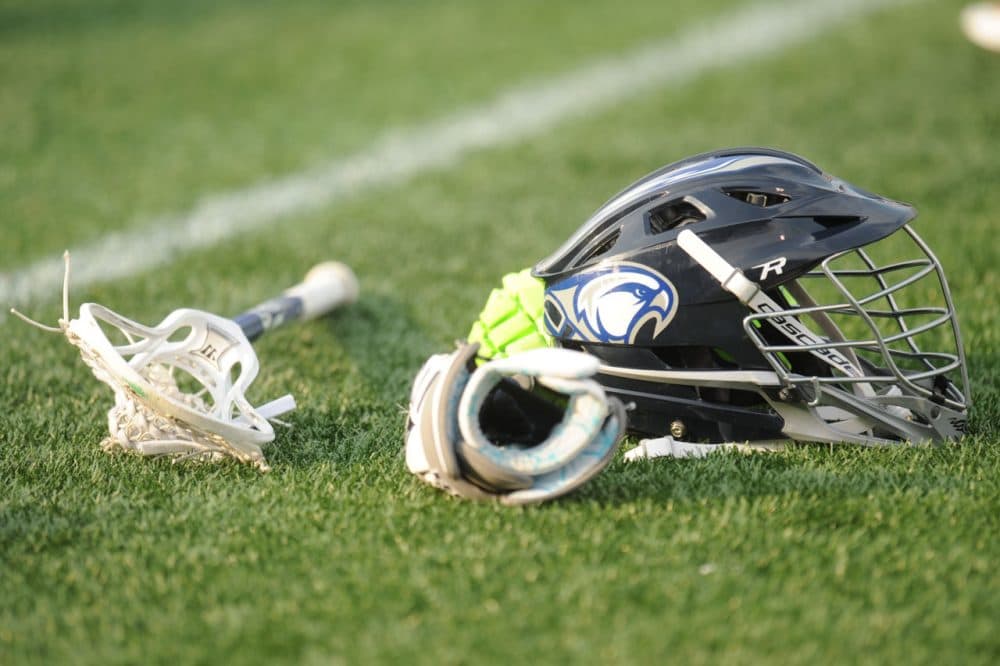Advertisement
Expert Says: Helmets Won't Reduce Concussions In Girls' Lacrosse
Resume
Not everyone agrees that helmets would make girls' lacrosse safer. Dr. Michael O'Brien, director of the Sports Concussion Clinic at the Micheli Center for Sports Injury Prevention in Massachusetts, joined Bill Littlefield to explain why he thinks technology isn't the answer.
BL: Let's start with the most basic question: do helmets protect any athlete — lacrosse or otherwise — from suffering a concussion?
[sidebar title="If It's Good Enough For the Boys..." width="630" align="right"]Dawn Comstock tells Bill Littlefield why she thinks girls' lacrosse players should wear helmets.[/sidebar]MO: There's certainly information out there that shows they absorb force. But there's really several parts of concussion I think a lot of people don't understand. And most of what people are trying to prevent is catastrophic injuries, like skull fracture or intracranial bleed. The concussions come more from diffuse injury where the brain rotates in the skull.
BL: Obviously helmets don't have anything to do with stopping that.
MO: Right. Unfortunately that's true because if you think about what happens with what's called rotational acceleration — that's where the brain rotates in the skull either by a moving head that hits an immovable object and the brain spins in the skull, so to speak, or if there's a massive force to the body and there's a rapid whiplash to the head — a helmet can't prevent that type of thing.
Now if you look at NASCAR, they have an excellent system for trying to reduce that rotational acceleration — like a seat belt for the head and helmet. On the field for an athlete, that's not particularly practical.
BL: You spoke of catastrophic head injuries. How often does somebody in girls' lacrosse suffer such an injury?
I think the literature bears this out: when helmets are added ... that’s when there’s a very big difference in aggressiveness in tackle or collision style.
Dr. Michael O'Brien
As helmets were added, deaths from catastrophic injury decreased exponentially. However, spinal cord injuries increased. So for collision sports, helmets work well to prevent skull fractures and hemorrhage. They can add unintended consequences though.
BL: Even one head injury is one too many for the player and the player's family, obviously. So why not add helmets to the girls' game, assuming they don't do any harm?
MO: Well, I agree with the first statement to say one head injury is too many. Unfortunately, I think there's going to be a base head injury rate for contact sports that's going to be hard to reduce to zero. Why not add a helmet if they're not going to do any harm is a good question. But I recognize that every person involved in this is intending to do the right thing — reduce injuries — but as a scientist I perhaps think about it different than a parent.
I want to look at the available evidence and say No. 1: does the proposed equipment do what you're intending it to do? That is, is the helmet going to reduce concussion in this sport? And No. 2: if it does, what's the best helmet? What's the best design? And for the Florida case that started our discussion, I think, unfortunately, there's no consensus on design or what's being mandated.
BL: People have described the most popular headgear in Florida as a headband -- a 10-millimeter-thick headband — not, perhaps, really a helmet at all. Is that something that families should consider as far as you're concerned?
[sidebar title="Complete Concussions Coverage" width="630" align="right"]Since our debut in 1993, OAG has tracked the latest information and research on sports concussions.[/sidebar]MO: I think there's very little value to it. It does not cover some of the most vulnerable spots for lacrosse or getting hit by a ball. Certainly don't expect it to decrease diffuse injuries and rotational acceleration. The only risk I see to it is the theory that it will increase aggressiveness among the athletes playing.
I've seen that for sure and I think the literature bears this out: when helmets are added — particularly when facemasks are added — that's when there's a very big difference in aggressiveness in tackle or collision style. Now the headband — I'm not sure it's going to increase aggressiveness significantly but, by the same token, I don't think it offers a lot of protection.
BL: So what can athletes do to limit the likelihood of getting a concussion?
MO: Rather than looking for equipment or technology to reduce rotational acceleration, we at the Micheli Center look at the athlete's individual risk. So, again, we're trying to reduce rotational acceleration.
I would say if you pick three things to try to reduce someone's risk of concussion it would be strengthening their upper back and neck muscles; training so that they have collision anticipation — if they're focusing too much on the stick and they get a collision that they don't see coming, you can bet there's going to be a much more violent rotation of the head; and No. 3 is definitely rule changes. There's a lot of evidence that illegal hits are really among the biggest reasons for head injuries and eye injuries, and oftentimes they're not being called with a penalty let alone disqualifications.
This segment aired on April 4, 2015.